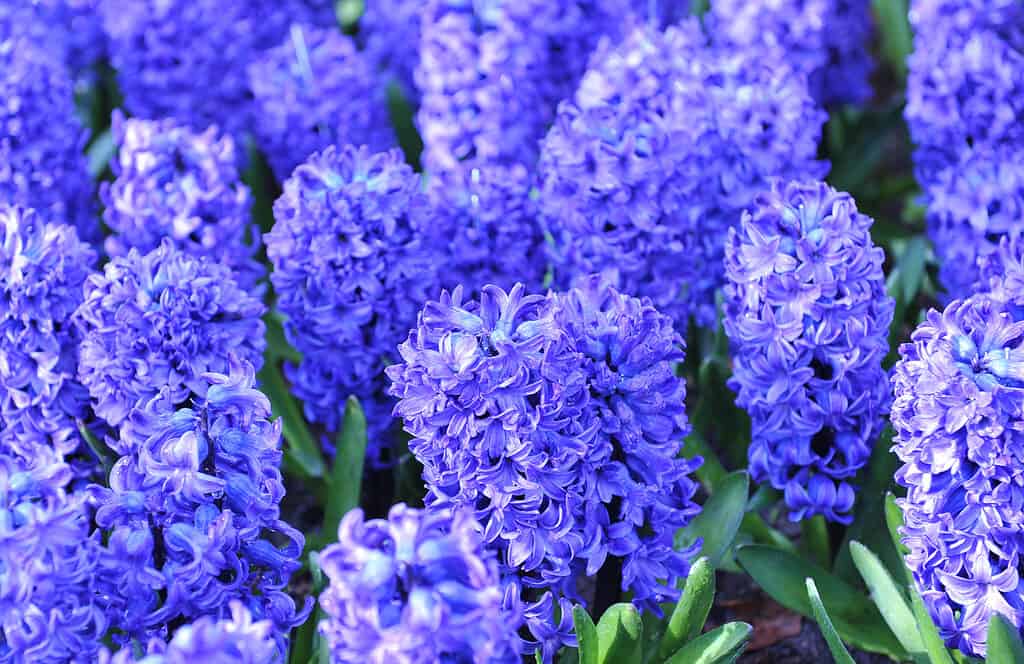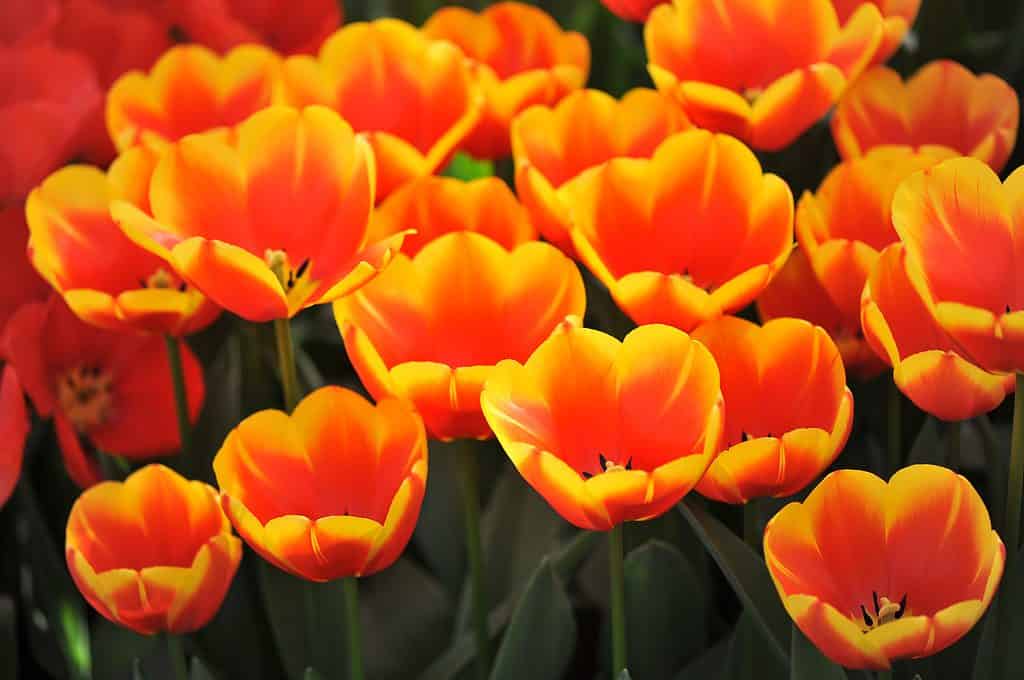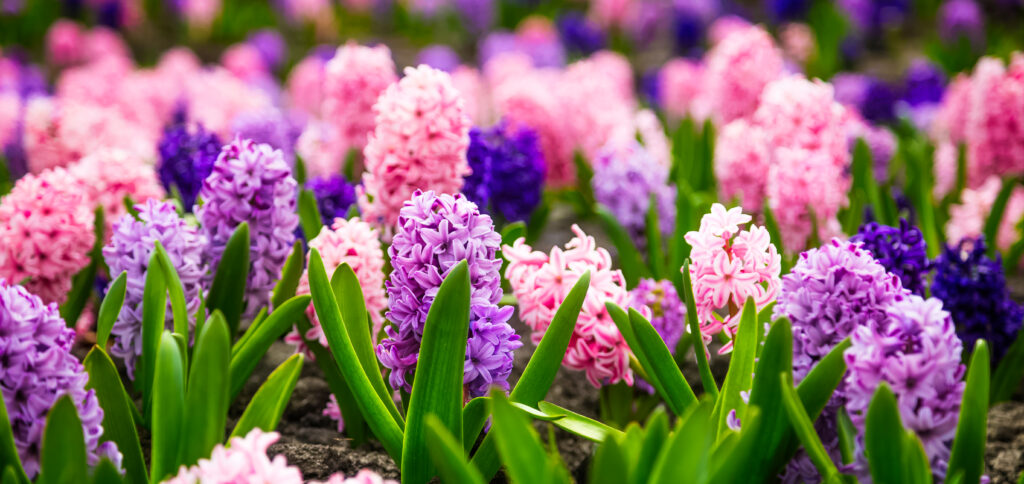When you smell the heady perfume of a pink or purple hyacinth, you know it’s spring. Tulips bloom around the same time as hyacinths, or slightly earlier. Their cheerful, colorful bell-shaped heads are another sign of the season.
The two flowers have some interesting overlaps in their uses and histories, but they are very different flowers.

Hyacinth (Hyacinthus orientalis) Blue Star blooms in a garden in April
©Sergey V Kalyakin/Shutterstock.com
| Tulips | Hyacinths | |
|---|---|---|
| Classification | Tulipa, over 110 species, thousands of hybrids and cultivars | Hyacinthus; 3 main types including single, double, and multiflora; many varieties and cultivars |
| Description | Tulips come in a wide array of colors from palest of creams to deepest of purples (almost black). They usually have 2 to 3 leaves and a single flower atop the stem. | Hyacinths grow between 4 and 6 untoothed leaves, emerging from the bulbs, with aromatic flowers on spikes in many colors from apricot to deep red. |
| Uses | Tulips are used for cutting gardens, herbal gardens, and ornamental gardens. When in herbal gardens, they might be used for skin care treatments or culinary garnishes or instead of onions. | Hyacinths are highly aromatic flowers that are used in perfumes heavily, as well as ornamental and herb gardens. They may be used in skincare products or medications but are more well-known for their aesthetics. |
| Origins and growing preferences | Dating back at least to the 10th Century as cultivated flowers, tulips have a long history from the Ottoman Empire to Holland where they are still highly favored. They need full sun and properly draining soil. | Hyacinths date back at least 4000 years as cultivated plants in Ancient Greek mythology in the tale of Hyacinth and his lovers. The flowers require full sun to partial shade and should be planted in autumn. |
| Fun facts and special features | Tulips symbolize many things like romantic love, apologies, cheerfulness, and happiness, or even purple as a sign of royalty. | Hyacinths show different meanings through their varying colors: white for love and prayer, purple for deep regret, pink for playful joy. |
Key Differences Between Tulips and Hyacinths
It’s unlikely folks would confuse hyacinths for tulips, but even apart from their stunning good looks, these flowering plants have many unique differences, as well as some overlapping history.
Tulips vs. Hyacinths: Classification

Beautiful orange-yellow Darwin hybrid tulips
©Sergey V Kalyakin/Shutterstock.com
Tulips are botanically known as Tulipa, a genus of flowers belonging to the Liliaceae or lily family. They are bulbous plants with large, ostentatious blooms favored the world over for their color, forms, and uses. Tulips are cool and cold weather climate flowers, unable to survive in tropical environments, as they require a cold, dormant season.
Hyacinthus are also a genus of bulbous flowers. They belong to the Asparagaceae family (asparagus) and the subfamily Scilloideae. They are known as hyacinths, commonly, and contain multiple species including true hyacinths, but not grape hyacinths (Muscari) though they have similar care needs. Hyacinths used to be classified among the Liliaceae family, as well, but have been removed and classified separately. There are three main types of hyacinths, including single, double, and multflora hyacinths.
Tulips vs. Hyacinths: Description

Tulip Princess Irene, delightful color combination of orange with purple flames
©iStock.com/ValerijaP
Each tulip plant produces two or three thick blue-green leaves that cluster toward the bottom of the stem or base of the plant. Except in rare hybrids or mutations, each stem produces a single bell-shaped flower that may come in any of a huge array of colors and shades, except any true blues. Some of the most commonly seen tulip colors include:
- Red
- Pink
- Orange
- White
- Yellow
- Bicolor
- Mauve
- Purple
- Almost black
- Multi-color forms
- Brownish red
- Burgundy
- Pale purple
- Violet
- Striped
Hyacinths, on the other hand, grow between 4 and 6 leaves, in most cases, emerging from the bulb of the flower. The intensely aromatic blooms come in an array of colors, as well, usually in pink, white, purple, pink, blue, burgundy, cream, apricot, salmon, pale yellow, mauve, lilac, or rose. The stems themselves are leafless but serve as a spike for the many blossoms per each.
Tulips vs. Hyacinths: Uses

Dark purple Queen of Night tulips in bloom
©Printemps PhotoArt/Shutterstock.com
Gardeners have long favored tulips in a range of plant beds and gardens. They are popular in cutting gardens where the blooms are cut for bouquets, boutonnieres, gift baskets, and floral arrangements, to herbal flower gardens where the gorgeous flowering edible plants bloom each year. Grow tulips in flower beds, raised beds, container gardens, single pot displays, cutting gardens, and edible gardens. The flowers and bulbs are both edible and medicinal. Manufacturers use them in skincare products for treating minor skin irritations, insect bites and stings, and dry skin. Chefs use them to replace onions or garnish dishes and salads.
Hyacinths are also extremely popular for both aesthetic and medicinal purposes. The bright flowers offer up incredible aromas that make them popular as border plants and flower bed plants. You can plant them in pots and bring them indoors or grow them as hydroponic plants in specialized hourglass-shaped glass jars. Grow them in container gardens, pollinator gardens, or even cutting gardens, as well as some herbal gardens.
Perfumers use hyacinths for their incredible scents used in popular, familiar, and less familiar brands. Some of those include Goutal Paris Grand Amour, Chanel Cristalle, Floris Edwardian Bouquet, and Hermès Un Jardin Sur Le Nil. People use hyacinths to treat eczema, in skin moisturizers and antimicrobial/antifungal/antibacterial products, treating cholera, sore throats, and even mild snake bites, and other ailments.
As with the case of all herbal medicine uses, please consult a medical care provider before attempting any such herbal remedies at home.
Tulips vs. Hyacinths: Origins and Growing Preferences

Red hyacinth (Hyacinthus orientalis) Jan Bos blooms in a garden in April
©Sergey V Kalyakin/Shutterstock.com
Tulips date back to at least the 10th Century as cultivated blooms. They were the Ottoman Empire’s symbol. Scholars believe the flowering plant originated in Central Asia, then spread across the planet over the millennia. It reached the Netherlands by way of Carolus Clusius who received bulbs and cultivated them for the western world in the late 1500s. In the early 1600s, the flowers became so wildly popular that their buying and selling actually crashed the stock market. The flowers slightly lost popularity after “Tulip Mania.” Their popularity continues to make them one of the three most sought-after flowers in the world.
To grow tulips, plant the bulbs, pointed end upward, about 6 to 8 inches apart in well-draining soil where the plants will receive full sun.
Various sources tell us that the term hyacinth may date back as far as 4,000 years ago, pre-Ancient Greek, to the Thracopelasgian dialect. The word’s meaning connects to the most famous hyacinth shade (the purplish-blue), in relation to water. The belief is that this attaches to the “true hyacinth” (Hyacinthus orientalis). This parent of the modern-day hyacinth, often referenced as Dutch hyacinth, grew wild in the Mediterranean back in those days, as well as throughout Asia Minor, Syria, and Persia (Iran).
The flower became highly popular in Greek, thanks to the legend of Hyacinthus and his lovers, and has continued to blossom in popularity throughout the world since that time. We credit the same original western cultivator of the Tulip, Carolus Clusius, for the western cultivation of the hyacinth, as well. His skills as a botanist and bulb-growing specialist helped to turn the Netherlands into the bulb-growing capital of the world.
Growing hyacinths is fairly easy. The flower needs full sun to partial shade, with at least 6 to 8 hours of daylight per day. Plant them in autumn three to six inches apart, about six to eight weeks before the first hard frost comes. They prefer slightly acidic soil that is loose and well-draining and that isn’t laden with compost.
Tulip vs. Hyacinth: Special Features and Fun Facts

The many colors of hyacinths have different meanings and, surprisingly, aromas.
©Kateryna Mashkevych/Shutterstock.com
Both tulips and hyacinths symbolize spring in much of the world. There are other intriguing facts and special notes on each flower as well.
- Both tulips and hyacinths are some of the longest-lasting vase flowers.
- Yet tulips only bloom for 3 to 7 days when planted in the ground.
- Hyacinths have a vase life of between 7 and 10 days.
- The modern tulip industry began in Holland in the late 1500s or early 1600s. They were cultivated long before this, but it wasn’t until they hit the European craze that the industry really took off. They remain one of the most popular flowers in the world these 400+ years later.
- Hyacinths appear in Ancient Greek mythology. The flowers are named for the legendary young Hyacinth who was killed when Zephyrus and Apollo fought for the young hero’s affection. It’s said that the flowers sprung forth from the place where the young god’s blood was spilt.
- Holland remains the largest producer of tulips today. And the nation is also the largest grower of hyacinths today, despite both flowers originating elsewhere in the world. Holland sells upward of 3 billion tulip bulbs annually.
- Different colors of hyacinths and tulips carry different meanings. Purple hyacinths mean deep regret while white tulips are the flower of apology. Pink hyacinths are flowers of playful joy, while yellow tulips symbolize cheerfulness and happiness. White hyacinths symbolize love and prayer, while red tulips represent romantic love.
- The hyacinth is a member of the asparagus family. Yep. The veggie family.
- Striped tulips get their unique coloring not from breeding but from a virus. Until the 1930s, people thought the stripes were rare color forms and so these plants sold for a lot of money. But in 1931, scientists discovered the stripes were the result of a virus carried by aphids. Now, we get the stripes from the DNA artificially created and implanted by scientists.
- Hyacinths come in many colors and, interestingly, each color carries not only its own significance but its own scent. The luscious flowers are often used in perfumery because of this.
The photo featured at the top of this post is ©
Thank you for reading! Have some feedback for us? Contact the AZ Animals editorial team.






